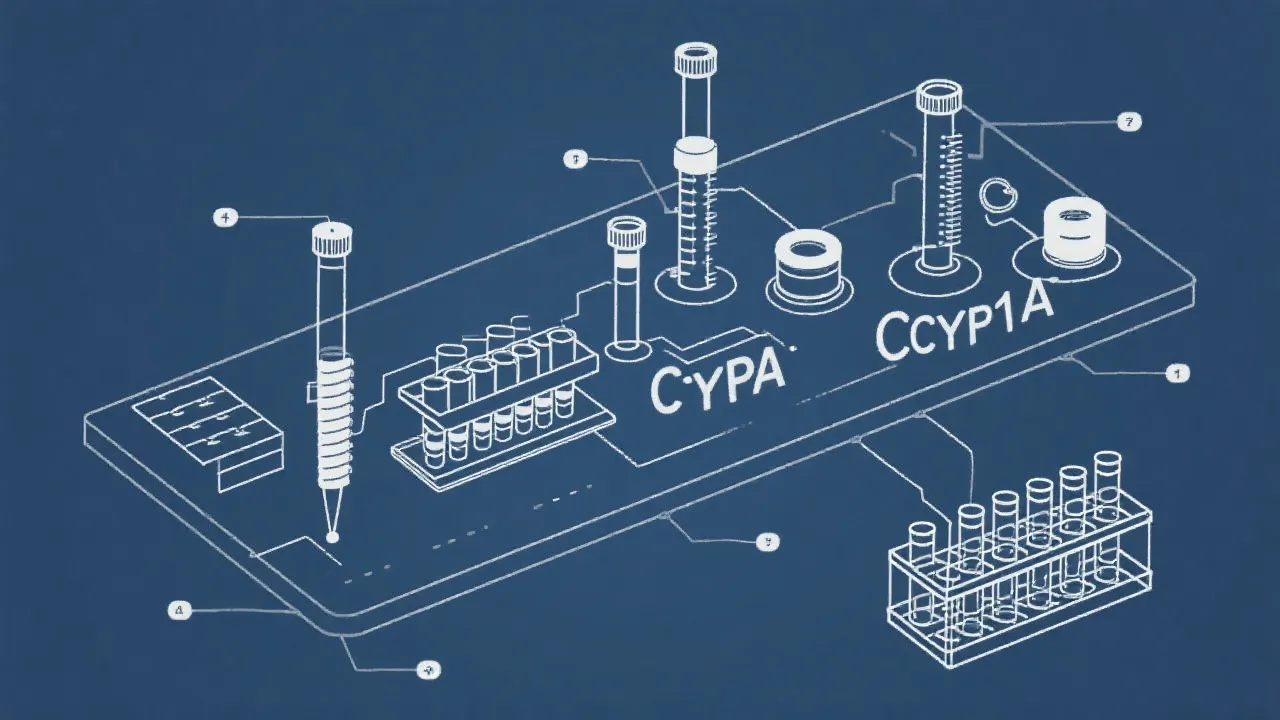Understanding Cyp1a1 Assay Techniques
The Cyp1a1 assay is a pivotal biochemical tool used to assess the enzyme activity linked to the CYP1A1 gene, vital in drug metabolism and the detoxification processes. Through various assay techniques, researchers can explore the implications of gene expression levels on pharmacological responses and toxicological effects, which aids in understanding human health impacts.

Introduction to Cyp1a1 Assay
The Cyp1a1 assay is an integral instrument in biochemical research, aimed at determining the activity levels of the CYP1A1 enzyme—a key player in drug metabolism and the body's detoxification mechanisms. This enzyme is part of the cytochrome P450 superfamily, renowned for its role in the oxidative metabolism of a wide array of xenobiotics and endogenous compounds. Understanding the implication of its activity is crucial in pharmacology and toxicology, allowing for the assessment of potential drug interactions and the impact of environmental toxins on human health. The ability to effectively measure CYP1A1 activity provides necessary insights that significantly contribute to both clinical outcomes in patient therapies and environmental health assessments.
The Scientific Basis of Cyp1a1 Assay
The Cyp1a1 assay utilizes various methods to evaluate the gene expression and enzymatic activity of CYP1A1. This enzyme is known for metabolizing polycyclic aromatic hydrocarbons (PAHs) and is induced by exposure to certain environmental pollutants. A surge in CYP1A1 expression can lead researchers to identify enhanced metabolic activation of procarcinogens, thus highlighting risks associated with specific chemicals. This makes the assay an essential tool for environmental health studies, drug safety evaluations, and understanding carcinogenesis mechanisms. Notably, the role of CYP1A1 in drug metabolism extends to the processing of various drugs, which can either enhance their effects or lead to toxic byproducts. The interaction of CYP1A1 with numerous pharmaceutical compounds is an area of intensive investigation, particularly concerning complex polypharmacy scenarios commonly encountered in clinical settings.
Techniques Used in the Assay
Seamless integration of modern techniques in Cyp1a1 assays is crucial. Common methodologies include:
- Reverse Transcription-Polymerase Chain Reaction (RT-PCR): This technique aids in quantifying mRNA expression, making it easier to observe changes in gene expression levels in response to various stimuli. This method is particularly valuable for detecting how different chemicals, diets, or environmental stressors influence CYP1A1 expression over time.
- Western Blot Analysis: This method is pivotal for detecting and quantifying protein levels of CYP1A1, confirming its presence and relative abundance in biological samples. By quantifying protein levels, researchers can correlate the mRNA expression data obtained from RT-PCR with functional enzyme levels in tissues or cell lines.
- Enzyme Activity Assays: These measure the conversion of substrates through the CYP1A1 enzyme system, providing direct insights into its metabolic capacity and the functional consequences of any detected changes in activity. Enzyme activity can be measured using various substrates that are specific to CYP1A1, allowing for a detailed investigation of enzyme specificity and efficiency.
- Cell Culture Techniques: Using transfected cell lines that overexpress CYP1A1 or knockout models helps in understanding the enzyme’s role in various biological contexts. This allows for the examination of specific responses to drugs or environmental agents while controlling for other metabolic pathways that may confound results.
- Mass Spectrometry: This advanced analytical technique offers high sensitivity and specificity in detecting the metabolites produced by CYP1A1. By analyzing metabolic products, researchers can gather comprehensive data regarding CYP1A1’s biotransformation capacity for a range of substrates.
Applications in Modern Research
Cyp1a1 assays are employed in diverse research fields, from pharmacology to toxicology. These assays help elucidate the mechanisms underlying drug clearance and bioactivation, leading to optimized dosing strategies that minimize adverse effects while maximizing therapeutic efficacy. For example, in cancer research, understanding how CYP1A1 metabolizes specific chemotherapeutic agents can inform clinicians about potential variations in drug responsiveness among patients based on genetic variations or prior exposure to environmental carcinogens.
In toxicology, Cyp1a1 assays reveal insights into how environmental pollutants might escalate health risks at the cellular level, prompting necessary regulatory actions to safeguard public health. The capability to analyze CYP1A1 induction in human populations allows epidemiologists to connect environmental exposures to adverse health outcomes more accurately. Moreover, research into the role of CYP1A1 in developmental biology has shed light on how this enzyme influences fetal exposure to teratogenic compounds present in the environment, which is particularly relevant in studies of maternal health and child development.
Furthermore, in the context of environmental science, Cyp1a1 assays have been instrumental in biomonitoring strategies, where the level of CYP1A1 expression serves as a biomarker for exposure to specific toxic pollutants. In wildlife studies, this can lead to more informed conservation efforts and risk assessments regarding habitat safety, as understanding CYP1A1 activity provides insights into how exposure levels affect organism health and survival.
Challenges and Considerations
Despite advancements in assay techniques, several challenges persist, including variability in assay results due to different laboratory conditions or biological sample inconsistencies. Factoring in genetic polymorphisms in the CYP1A1 gene among individuals is crucial, as these can significantly affect enzyme activity. Variations such as single nucleotide polymorphisms (SNPs) can lead to substantial differences in enzymatic efficiency and substrate preference, impacting both drug metabolism and susceptibility to toxic agents.
Another consideration involves the potential for assay interference, where the presence of other compounds within a sample can affect the accuracy of CYP1A1 activity readings. This necessitates rigorous validation of assay conditions, including thorough controls and detailed analysis of sample composition. Additionally, the development of effective inhibitors for CYP1A1 is essential to establish the enzyme's specific contributions to observed metabolic reactions. As research progresses, refining assay methodologies will be crucial to mitigate these challenges and ensure robustness and reproducibility in results.
Furthermore, ethical considerations should not be overlooked when employing Cyp1a1 assays, particularly concerning human or animal studies. Obtaining informed consent for biological sample usage, ensuring humane treatment of animal models, and considering the environmental impact of the substances under study are all vital ethical obligations researchers must observe.
Step-by-Step Guide to a Cyp1a1 Assay
- Prepare the biological samples, such as liver microsomes or cultured cells expressing CYP1A1. It is advisable to use samples from multiple donors to account for genetic variability in enzyme expression.
- Set up the assay reactions with necessary controls and substrates specific for CYP1A1. Include both positive controls known to activate CYP1A1 and negative controls devoid of the enzyme to establish baseline activity levels.
- Incubate samples under defined conditions conducive to enzymatic activity (time, temperature, and pH). It is important to optimize these conditions to the specific requirements of the substrates used, as this can dramatically affect enzyme kinetics.
- Analyze samples post-reaction using techniques like spectroscopy to measure product formation, indicative of enzyme activity. This analysis may involve measuring fluorescence changes or using high-performance liquid chromatography (HPLC) for more precise quantification.
- Interpret results in the context of experimental goals, such as evaluating drug metabolism or pollutant toxicodynamics. Comparative analysis against standard curves can help determine the enzymatic activity quantitatively.
- Document all findings in accordance with good laboratory practices, noting any anomalies or outliers that may necessitate further investigation.
- Consider further experimental replication to solidify findings, and where appropriate, engage in collaborative validation across different laboratories and research teams to enhance reliability.
Future Directions in Cyp1a1 Research
The future of Cyp1a1 research holds significant promise as science progresses into the realms of personalized medicine and environmental health at an unprecedented scale. An area ripe for exploration involves the integration of pharmacogenetics and transcriptomics, where understanding individual genetic backgrounds can lead to tailored therapeutic strategies. By identifying patients who carry polymorphisms affecting CYP1A1 activity, healthcare providers can adjust medication types and dosages to enhance efficacy and reduce adverse reactions. This personalized approach not only optimizes treatment outcomes but also boosts patient safety by minimizing the risk of toxic buildup from ineffective drug metabolism.
Furthermore, the rise of advanced analytics and artificial intelligence (AI) methods in data assessment offers new opportunities for uncovering complex interactions involving CYP1A1. These technologies can process vast datasets from genomic studies, lifestyle surveys, environmental assessments, and clinical trials to identify patterns and correlations that were previously undetectable. For example, AI could help construct predictive models that incorporate both genetic predisposition and environmental interaction, providing holistic insight into individual responses to drugs and toxins.
Research on CYP1A1's role in non-canonical pathways also presents exciting avenues. For instance, investigations into how CYP1A1 metabolites influence cellular signaling pathways in cancer, inflammation, and cellular repair mechanisms can offer novel therapeutic targets. By elucidating these mechanisms, scientists may be able to develop compounds that modulate CYP1A1 activity in desirable ways, either by boosting its detoxifying functions or by inhibiting its role in the bioactivation of carcinogenic compounds.
Finally, promoting a collaborative and interdisciplinary approach that combines chemistry, biology, environmental science, and clinical research will be vital in advancing Cyp1a1 research. Cross-disciplinary input can provide comprehensive perspectives on the enzyme's relevance throughout various fields, leading to innovative pathways for addressing contemporary health challenges. As global efforts increase to mitigate the effects of pollutants and enhance drug safety, Cyp1a1 assays will undoubtedly remain a critical component of this dynamic research landscape.
FAQs
- What is the primary objective of a Cyp1a1 assay?
The primary objective is to assess the enzymatic activity and expression levels of CYP1A1, essential for understanding its role in drug metabolism and environmental chemical processing. It provides valuable information regarding how substances are transformed within the body, which is critical for patient safety and treatment efficacy.
- How does genetic variance affect Cyp1a1 assay results?
Genetic polymorphisms in the CYP1A1 gene can lead to variations in enzyme activity across different populations, influencing the outcome and interpretation of assays. These variants may result in individuals being classified as poor, extensive, or ultra-rapid metabolizers, which can significantly impact clinical drug responses and toxicity risks.
- Can Cyp1a1 assays predict individual responses to drugs?
While they can provide insights into potential metabolic variations, personalized predictions require comprehensive genomic and phenotypic data integration. It is important to study CYP1A1 alongside other relevant pathways and genetic markers for a more complete understanding of drug metabolism.
- Are there any environmental factors that can influence CYP1A1 expression?
Yes, various environmental factors such as exposure to polycyclic aromatic hydrocarbons (PAHs), certain dietary components, and even lifestyle habits like smoking can induce or inhibit CYP1A1 expression. Understanding these influences helps in evaluating the risk posed by environmental toxins and optimizing therapeutic interventions.
- What types of substances are typically analyzed in Cyp1a1 assays?
A wide range of substances can be analyzed, including pharmaceuticals, environmental pollutants, and dietary components. Common substrates for CYP1A1 assays include caffeine, acetaminophen, and benzo[a]pyrene, among others, as they provide insight into different aspects of drug metabolism and detoxification processes.
Cyp1a1 assays remain a cornerstone of contemporary biochemical and pharmacological research. By continually refining these methodologies, scientists can better predict and mitigate the impacts of drugs and environmental chemicals on human health, advancing the field of precision medicine. As research evolves and expands, the growing understanding of CYP1A1's multifaceted roles will undoubtedly lead to improved health outcomes, personalized therapies, and enhanced environmental safety protocols.





